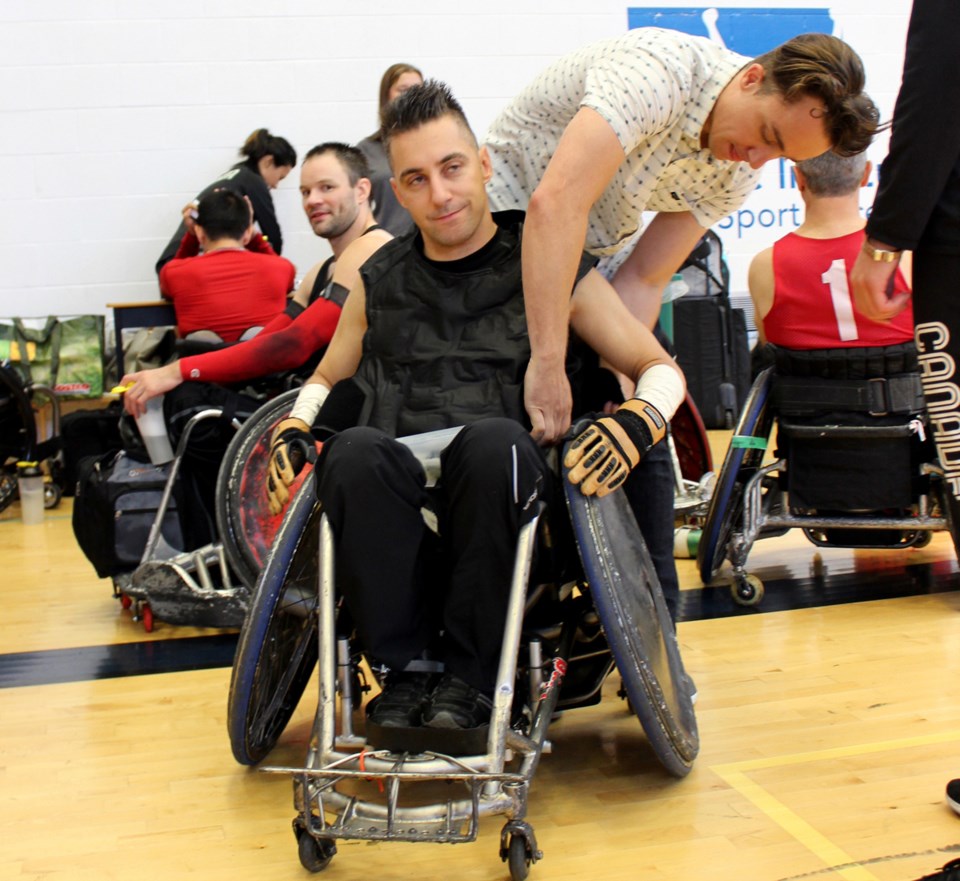Jaymes Williams and Laura Hutchinson, of Kwantlen Polytechnic University’s Richmond-based Product Design and Fashion and Technology program, have developed a specially designed set of cooling vests for members of Canada’s wheelchair rugby team.
Williams said that paraplegics have difficulty regulating their body temperature and that could make the difference between making the podium or not.
“Essentially, they have a hard time sweating and their core temperatures can spike quite quickly,” he said, adding traditional methods to help them cool off have involved sprays, misters, drinking slushy iced beverages and applying cool, wet towels to skin surfaces.
“When you’re in a game, the last thing you want to do is drop out because it’s way too hot.”
And when it came to the needs of the wheelchair rugby team, their specially designed wheelchairs allowed only certain parts of their body to be cooled. So, there was a need to develop a vest that can be worn on the sidelines during breaks in the action. And for Williams and Hutchinson, that became a class project.
“We ended up meeting staff from the Canadian Sports Institute at the Richmond Oval and we learned about the problems these athletes have to overcome,” Williams said.
“And thermal regulation was one I was particularly interested in. They were playing around with these cooling vest ideas that weren’t working for them. So, I saw this opportunity to use my education and design perspective to improve things.”
That was about 18 months ago.
Since then, the class project graduated into a full-blown research project that utilized other forms of funding and assistance from a Vietnam-based sports apparel firm called Maxport JSC, which develops products for large, brand name companies such as Lululemon, Nike, Adidas and Under Armour.
“That was absolutely amazing,” said Williams, who along with Hutchinson travelled to Hanoi last June to work with Maxport’s team to advance the design of the vests. “They were fundamental in helping fit the garments properly.”
The project also received funding for the pair to attend the Parapan Am Games in Toronto last summer.
“There, I was able to really experience the community of adaptive sports,” Williams said.
Then, this April, the Canadian Sports Institute approached them to see if a set of cooling vests could be produced for the Paralympic Games in Rio which run Sept. 7-18.
“That’s what we’ve been spending the last four months on,” Williams said.
The vest is relatively simple in design. It features a bladder that has been laminated on the inside which is then injected with a cooling liquid. “We have two different strategies,” Williams said. “One is just to use water and the other is what’s called a phase change material which is a liquid that can freeze at a higher temperature, in this case 12 C.”
That level is ideal for cooling down body temperature without inducing shock with a zero degree ice vest.
“You start cramping when you apply too much cold. We want to slowly cool down the body temperature,” Williams said, adding the vests are worn during warm-ups before the game, on the sidelines and after the game.
“Before, they were using what was basically a sheet of ice cubes and were velcroing them around their bodies,” he said. “They didn’t have a functioning product they could wear and feel confident in. Plus, our version looks more like a piece of sportswear rather than a medical device.”
After being frozen, the vest’s liquid can stay at 12 degrees for about two hours.
“That means it could last for pretty much a whole game,” Williams said, adding the vest can also be “recharged” quickly in a cooler because of its high freezing point.
Away from the elite sports arena, the vest has medical applications and even everyday use, which could attract the attention of a major sports apparel firm.
Those are all avenues to explore after the games have concluded because right now, all efforts are on helping the Canadian team, Williams said.
“I want to help people. That’s pretty much what I am in it for,” he said. “And to provide the athletes with something they can feel confident in and will help them, there’s a lot of pride in that.”
“They (wheelchair rugby team) are seeded to potentially win a medal, and if they do and get a gold, I couldn’t be more proud of the research project and what we’ve learned and achieved.”



